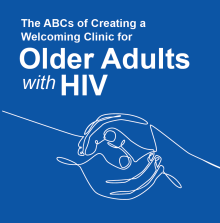Image

A guide with tips for clinics serving older people with HIV to enhance the patient experience and improve retention.
- Clinic is fully accessible (e.g., handrails, ramps, seating with support & stability, bathrooms equipped with emergency pull strings, & no fall hazards)
- Pamphlets, signs, forms, & paperwork have larger-sized fonts
- Staff are available to assist with smartphone applications (e.g., patient portal & telehealth apps) & other patient communication tools (e.g., text messages or emails)
- Paper forms & documents are available with health literacy accommodations
- Professional medical interpreter services are available in the patient’s primary language & provided as needed
- Background noises are kept to a minimum (e.g., waiting room TV or music)
- Cognitive assessment completed (e.g., patient engagement, level of awareness, interaction with environment)
- Motor function assessments completed
- Vision & hearing assessments completed
- Mental health assessments completed
- Alcohol & substance use assessments completed
- Pain assessment completed
- Patient identified supports (e.g., relatives, friends, spouse/partner, &/or community-based advocates) assessed & documented
- Assess for & address social isolation & elder mistreatment
- Recognition & collaboration with community-based organizations & agencies (e.g., home care, transportation, food services, & legal services that are HIV, LGBTQIA+, & senior welcoming)
- Establish outpatient follow-up to ensure patient understands & can implement plan
- Eligibility assessment & referral to long-term care settings as needed
- Suggest patient journaling to keep track of questions & concerns before, during, & after each visit
- Provide simple step-by-step instruction sheets for self-monitoring tasks (e.g., blood pressure, blood sugar)
- Remind patients to have a list of their medications & supplements at every visit
- Assess information retention through teach-back method & questioning
- Review coordination of care team roles, follow up appointments, & means of communication with patient
- Coordinate specialist consultations as needed
- Identify status of healthcare proxy & living will
- Identify what matters most for each patient at each visit
- Speak slowly with direct eye contact
- Include diverse populations & groups (i.e., LGBTQIA+, multicultural, spirituality) in visual materials & language used with patients; ensure relevance to care
- Use motivational interviewing
- Discuss & counsel on sexual health
- Assure patient needs are being addressed through referrals & team based care
- Panel on Antiretroviral Guidelines for Adults and Adolescents. Guidelines for the Use of Antiretroviral Agents in Adults and Adolescents with HIV. Department of Health and Human Services. 2024. Accessed April 17, 2024.
- American Psychological Association. (n.d.). Older adults with HIV: An overlooked population? American Psychological Association.
- Assessing cognitive impairment in older patients | National Institute on Aging. (n.d.-a).
- Centers for Disease Control and Prevention. (2022, May 6). Getting started. Centers for Disease Control and Prevention.
- Centers for Disease Control and Prevention. (2022b, September 21). How older adults make health decisions. Centers for Disease Control and Prevention.
- Centers for Disease Control and Prevention. (2021, June 21). Measuring skills and experiences. Centers for Disease Control and Prevention.
- Dydyk, A. M. (2023, January 29). Pain assessment. StatPearls [Internet].
- Gulledge, M. (2024, January 9). Seven steps to Keep & Attract Senior Patients. Review of Optometric Business.
- Jaks, R., Guggiari, E., De Gani, S. M., & Nicca, D. (2023, July 20). Patients’ perspectives on the use of a newly developed “patients’ guide for doctor’s visit”: Docvisitguide. International journal of environmental research and public health.
- O’Keefe, J. (n.d.). Creating a senior friendly physical environment in our hospitals. The Regional Geriatric Assessment Program of Ottawa.
- Resources for organizations. Regional Geriatric Program of Toronto. (2021, December 20).
- Seematter-Bagnoud, L., & Büla, C. (2018, May 1). Brief assessments and screening for geriatric conditions in older primary care patients: A pragmatic approach. Public health reviews.
- Vaportzis, E., Clausen, M. G., & Gow, A. J. (2017, October 4). Older adults perceptions of technology and barriers to interacting with tablet computers: A FOCUS Group Study. Frontiers in psychology.
- Centers for Disease Control and Prevention. What you can do to prevent falls. (n.d.). Brochure.
- World Health Organization. (n.d.). National programmes for age-friendly cities and communities: A guide. World Health Organization.
Download
Browse more
Languages